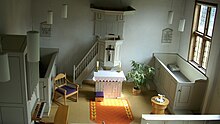Mennonite Church Friedrichstadt
The Mennonite Church (Danish: Mennonitterkirken ) in Friedrichstadt in Schleswig is an extension of the Old Mint City Museum . The church on the Mittelburgwall is also used by the Danish community today. There is a Mennonite cemetery right next to the church.
local community
Just two years after the town was founded by the Gottorf Duke Friedrich III. in 1621 Mennonites settled in the city. They came as religious refugees from the Netherlands and partly from nearby Eiderstedt , where parishes had existed since 1560 (cf. Anabaptists on Eiderstedt ). Together with Lutheran Protestants , Remonstrants , Catholics and Jews , they formed the new population and made Friedrichstadt early on into a place of religious tolerance in an otherwise purely Lutheran environment.
The Friedrichstadt Mennonites each formed a High German, Waterland, Flemish and Frisian community that worked independently of one another. Unlike the Remonstrants, they did not have their own church in the first few years. The meetings were held privately. The Friedrichstadt Mennonites worked primarily as traders and craftsmen. At the beginning of the 18th century their number was estimated at 400, which made up about 20% of the population. When the four congregations united to form a single congregation in 1708, they bought the Alte Münze warehouse and established the Mennonite church in a side building. Even in the 18th century, preaching was done here in Dutch .
church
The church was designed as a simple Mennonite preaching church with a central pulpit . It has neither a church tower, church bell nor pictorial decorations. Today the church is used as a simultaneous church by the Lutheran Danish community . Since then, there is also a crucifix and an altar in the room, which are otherwise not common in Mennonite churches. A pastor's board above the small baptismal font provides information about the Danish pastors who have worked there so far.
Today there are two organs in the interior . The organ on the gallery from 1852 can no longer be used today. This organ was built in 1831 as a school organ in Koldenbüttel and possibly contains pipes from the former organ of the St. Pauli Church in Hamburg-Altona, which was built in 1718–1721 by Otto Diedrich Richborn , a former employee of Arp Schnitger .
Next to the entrance to the church is the parish hall's room called Kamertje . Even if the Old Mint and the Mennonite Church are connected, the church was built at a much later date than the Old Mint, which was created in the style of the Dutch Renaissance. The church has been restored several times. The current design of the church interior corresponds to the state of the 19th century.
In a brick building right next to the church there used to be a school and pastorate for the parish. Today the 30-strong congregation is looked after by pastors from Hamburg-Altona . The Danish congregation shares a parish office with the Danish congregation in Husum and still holds services in Danish every Sunday.
graveyard
Behind the church is the Mennonite cemetery , where there are still many gravestones from the early 18th century. A burial book of the congregation from the 18th century can be viewed in the museum in the Alte Münze. The Mennonite cemetery is still in use today.
See also
Web links
- Website of the Mennonite Congregation
- Website of the Danish municipality
- Radio service from Friedrichstadt (Danish)
literature
- Jan von Busch: The lost Schreiber organ in Koldenbüttel and its organ-building organists . In: Ars Organi . tape 66 , no. 2 , 2018, p. 73–82 ( 73–76 online [PDF] The PDF file contains only the first four pages of the article.).
Individual evidence
- ↑ Busch 2018, pp. 77-78 and 80-81
Coordinates: 54 ° 22 ′ 36.2 ″ N , 9 ° 5 ′ 13 ″ E


